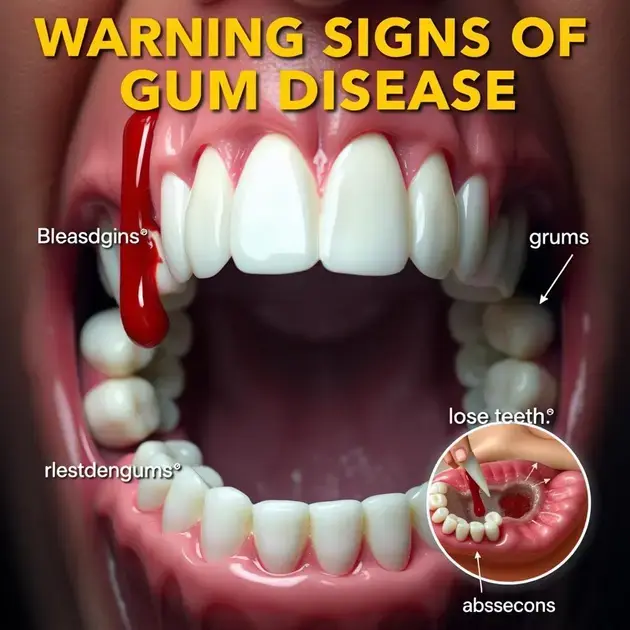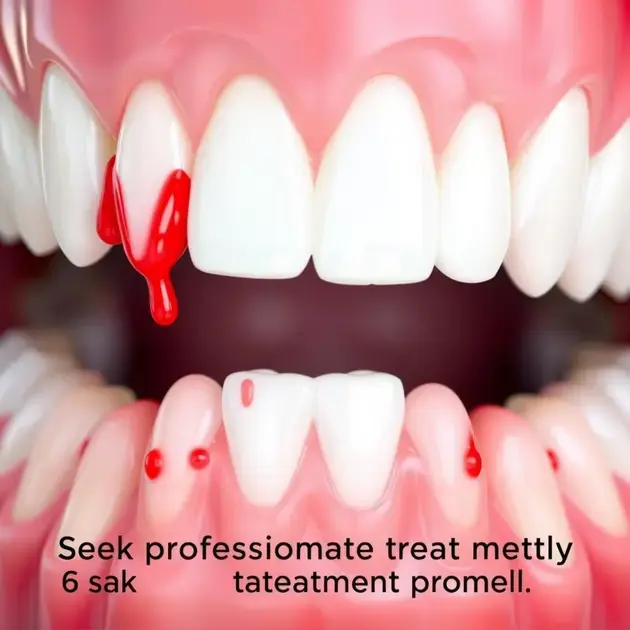Gum disease, also known as periodontal disease, affects millions worldwide and can lead to serious dental and health issues if left unchecked. Knowing how to identify signs of gum disease is essential for maintaining oral health. This comprehensive guide aims to arm you with the necessary knowledge to spot the early symptoms, hopefully leading to timely and effective treatment.
Recent studies have highlighted that early detection and treatment of gum disease can significantly improve long-term oral health outcomes. Swollen gums, redness, and bleeding during brushing or flossing are some common early indicators. It’s important to address these signs by consulting with a dental professional, as they can advise on the best practices and treatments to halt the progression of the disease and prevent further complications.

Early Signs to Watch Out For When Identifying Gum Disease
Identifying gum disease in its early stages is crucial for preventing further complications. Some of the early signs to watch out for include:
1. Bleeding Gums
If you notice your gums bleeding while brushing or flossing, it could be a sign of gum disease. Make sure to pay attention to any changes in your gum health.
2. Swollen or Tender Gums
Gum disease can cause your gums to become swollen or tender to the touch. If you experience these symptoms, it’s essential to consult a dental professional for proper evaluation.
3. Persistent Bad Breath
Bad breath that doesn’t go away even after regular brushing and flossing can indicate the presence of gum disease. Keep an eye on persistent bad breath as a potential early sign of gum problems.
4. Receding Gums
As gum disease progresses, you may notice your gums receding or pulling away from the teeth. This can lead to sensitivity and expose the roots of your teeth.
5. Changes in Bite or Tooth Alignment
If you experience changes in your bite or notice your teeth shifting position, it could be a sign of advanced gum disease. Seeking prompt treatment is essential to prevent further damage.
Common Indicators of Gum Disease You Shouldn’t Ignore
Ignoring the signs of gum disease can lead to serious oral health issues. Some common indicators that should not be overlooked include:
1. Loose Teeth
Advanced gum disease can cause the supporting structures of your teeth to weaken, leading to loose teeth. Ignoring this sign can result in tooth loss.
2. Pus Between Gums and Teeth
If you notice pus oozing from between your gums and teeth, it could indicate an infection caused by gum disease. This requires immediate attention from a dental professional.
3. Painful Chewing
Gum disease can make chewing painful, especially when consuming hard or crunchy foods. Don’t ignore this discomfort, as it could signify advanced gum issues.
4. Gum Abscesses
An abscess on the gums, characterized by a painful, swollen area filled with pus, is a severe indication of gum disease. Seeking treatment promptly is essential to prevent further complications.
5. Chronic Gum Inflammation
Constant redness, swelling, or tenderness in the gums can be a sign of chronic gum inflammation, a common indicator of gum disease. Regular dental check-ups are crucial to monitor and address this condition.
Consulting a Dental Professional for Effective Treatment of Gum Disease
When dealing with gum disease, seeking help from a dental professional is essential for effective treatment. Here is a step-by-step guide on how to consult a dental professional for gum disease:
1. Schedule a Dental Appointment
Start by scheduling an appointment with a trusted dental professional. You can use online platforms like Zocdoc to find and book appointments with dentists in your area.
2. Discuss Your Symptoms
During the consultation, make sure to discuss your symptoms and any concerns you have about your gum health. Provide your dentist with detailed information to help with the diagnosis.
3. Undergo a Comprehensive Examination
Your dental professional will perform a thorough examination of your gums, teeth, and overall oral health. This may include X-rays and other diagnostic tests to assess the extent of the gum disease.
4. Receive Personalized Treatment Plan
Based on the examination results, your dentist will develop a personalized treatment plan to address your specific gum disease issues. This may include deep cleaning, medication, or surgical procedures, depending on the severity of the condition.
5. Follow-up and Maintenance
After undergoing treatment, follow your dentist’s recommendations for oral care and attend regular follow-up appointments to monitor your progress. Maintaining good oral hygiene practices is crucial for preventing gum disease recurrence.

**Warning Signs That You Might Have Gum Disease**
Gum disease, also known as periodontal disease, is a common condition that affects the tissues surrounding the teeth. It is important to recognize the warning signs of gum disease in order to seek timely treatment and prevent further complications. Here are some key indicators that you might have gum disease:
Bleeding Gums:
One of the most common warning signs of gum disease is bleeding gums, especially during brushing or flossing. If you notice that your gums bleed easily and frequently, it could be a sign of gum inflammation and early-stage gum disease.
When untreated, bleeding gums can progress to more advanced stages of gum disease, leading to complications such as gum recession and tooth loss. It is essential to consult with a dentist if you experience persistent gum bleeding.
Proper oral hygiene practices and regular dental check-ups can help prevent and manage gum disease effectively. Maintaining good oral health habits is crucial in reducing the risk of gum disease and promoting overall oral well-being.
Remember to use a soft-bristled toothbrush and gentle brushing techniques to avoid irritating the gums further. Flossing daily and using an antiseptic mouthwash can also help in preventing gum disease.
If you are experiencing bleeding gums, do not ignore the warning signs. Consult with a dental professional to receive a proper diagnosis and personalized treatment plan for gum disease.
Receding Gums:
Another common indicator of gum disease is receding gums, where the gum tissue pulls back from the teeth, exposing the tooth roots. Receding gums not only affect the aesthetics of your smile but also indicate underlying gum health issues.
Receding gums can be caused by various factors, including poor oral hygiene, aggressive brushing, hormonal changes, and genetic predisposition. If left untreated, receding gums can lead to increased sensitivity, gum inflammation, and even tooth mobility.
To address receding gums and prevent further gum recession, it is essential to seek professional dental care. Your dentist may recommend treatments such as deep cleaning, gum grafting, or periodontal surgery to restore gum health and prevent complications.
In addition to professional treatment, maintaining good oral hygiene practices at home is crucial in managing receding gums. Using fluoride toothpaste, avoiding sugary foods and beverages, and quitting smoking can support gum health and prevent gum disease progression.
If you notice that your gums are receding, do not delay seeking dental treatment. Early intervention is key in preserving gum health and preventing the advancement of gum disease.
Conclusion
In conclusion, being aware of the warning signs of gum disease is crucial for maintaining good oral health. Bleeding gums can indicate early-stage gum disease, emphasizing the importance of regular dental check-ups and proper oral hygiene practices. Addressing bleeding gums promptly can prevent complications such as gum recession and tooth loss, highlighting the significance of seeking professional dental care if persistent gum bleeding occurs.
Furthermore, receding gums serve as another indicator of underlying gum health issues. Factors such as poor oral hygiene and aggressive brushing can contribute to gum recession, leading to increased sensitivity and potential complications. Professional treatments like deep cleaning and gum grafting, coupled with at-home oral care habits, play a pivotal role in managing receding gums and preventing the progression of gum disease.
By understanding and recognizing the warning signs of gum disease, individuals can take proactive steps to preserve their gum health and overall well-being. Early intervention, personalized treatment plans, and consistent oral care routines are essential in mitigating the risks associated with gum disease and ensuring a healthy smile for years to come.
